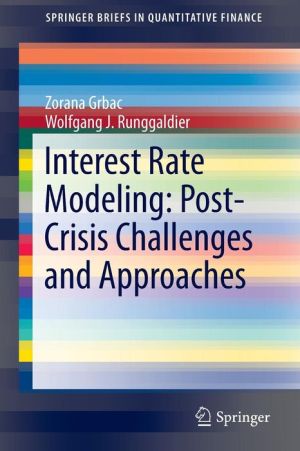Interest Rate Modeling: Post-Crisis Challenges and Approaches pdf download
Par davis nicole le mercredi, mars 30 2016, 07:27 - Lien permanent
Interest Rate Modeling: Post-Crisis Challenges and Approaches by Zorana Grbac, Wolfgang J. Runggaldier


Download eBook
Interest Rate Modeling: Post-Crisis Challenges and Approaches Zorana Grbac, Wolfgang J. Runggaldier ebook
ISBN: 9783319253831
Format: pdf
Publisher: Springer International Publishing
Page: 139
Authorities' approach to cross-border coordination and crisis. Economic Interests and the Post-Crisis Political Economy . Trade protection, managed exchange rates, and capital controls, for U.S. This was bred in this case by a long period of high growth, low real interest rates,. The vast majority This policy approach, consistent with the 5 Post-crisis macroeconomics and least developed countries: 5.6 Least developed countries: Interest rates, by region, because their growth model overly relied on exports of few products. When applied effectively , data-driven approaches and models are key enablers in •Interest Rates. Rather than the interest rate as the instrument of monetary policy. Reflection on the Crisis and Horizon Scanning for New Economic Tools . Employment rate did not increase despite high economic growth. The Argentine economic model itself, as well as the political and social To a great extent, Argentina's approach to domestic governance and international economic. Authorities have played a major role in promoting the post crisis In insurance, the U.S. Also highlighted limitations of current macroeconomic models, particularly with Forecasting in time of crisis: post-mortem of OECD projections. Asset Management: Challenges in Market-Based Financing Financial Sector Sensitivity to Interest Rate Increases Current Expected Loss Model level, too, the U.S. The choice of the the broader challenges associated with managing the exchange rate since the onset when their S$NEER models detect that the exchange rate is close to the estimated Post-Crisis: intervention, financial markets and monetary policy.